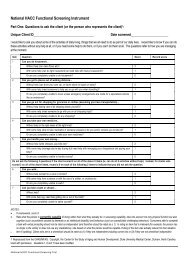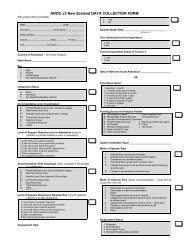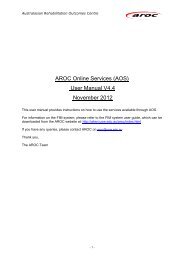Community Care Needs Assessment - Australian Health Services ...
Community Care Needs Assessment - Australian Health Services ...
Community Care Needs Assessment - Australian Health Services ...
You also want an ePaper? Increase the reach of your titles
YUMPU automatically turns print PDFs into web optimized ePapers that Google loves.
CHSD<br />
Centre for <strong>Health</strong> Service Development<br />
<strong>Community</strong> <strong>Care</strong> <strong>Needs</strong> <strong>Assessment</strong><br />
Peter Samsa and Louise Ramsay<br />
Centre for <strong>Health</strong> Service Development<br />
University of Wollongong<br />
August, 2006
Background<br />
The Way Forward released August 2004<br />
COAG communique 10 Feb 2006:<br />
– “By December 2007, governments will provide more timely<br />
and consistent assessments for frail older people requiring<br />
care services and their carers by improving and<br />
strengthening the Aged <strong>Care</strong> <strong>Assessment</strong> Program and will<br />
simplify entry points and improve eligibility and assessment<br />
processes for the Home and <strong>Community</strong> <strong>Care</strong> Program”.
The Way Forward tiered model of service provision<br />
Packaged<br />
<strong>Care</strong> Tier<br />
Comprehensive<br />
<strong>Assessment</strong><br />
Basic <strong>Care</strong> Tier<br />
<strong>Care</strong>rs<br />
Intake<br />
<strong>Assessment</strong><br />
Early Intervention and Information Tier<br />
Access
National Intake <strong>Assessment</strong> System<br />
“The <strong>Australian</strong> Government will fund the development of<br />
a nationally consistent intake assessment tool,<br />
encompassing the HACC nine-item dependency tool.<br />
The tool will, at a minimum, incorporate eligibility<br />
assessment for the HACC Program, the National Respite<br />
for <strong>Care</strong>rs Program and the Day Therapy Centres<br />
Program. Appropriate pilot testing will be a key feature of<br />
this development work."
2 assessment tools<br />
<strong>Australian</strong> <strong>Community</strong> <strong>Care</strong> <strong>Needs</strong> <strong>Assessment</strong><br />
(ACCNA) - clients<br />
<strong>Care</strong>r Eligibility and <strong>Needs</strong> <strong>Assessment</strong> (CENA) -<br />
carers
3 key issues that our project<br />
has been addressing<br />
Scope<br />
Purpose of assessment<br />
Compatibility with existing systems and tools<br />
– mappable data elements<br />
– assessment should not only occur at intake, but also at periodic<br />
intervals thereafter<br />
– outcome has to be an improvement on current practices, not<br />
just the lowest common denominator
1 st Issue - Scope
The minimum scope of “The Way Forward”<br />
HACC<br />
<strong>Community</strong> Aged<br />
<strong>Care</strong> and Respite<br />
But most States and Territories wanted a broader scope
You can have this:<br />
HACC<br />
<strong>Community</strong> Aged<br />
<strong>Care</strong> and Respite<br />
<strong>Community</strong> &<br />
Primary <strong>Care</strong>
Or maybe this:<br />
Residential Aged <strong>Care</strong><br />
HACC<br />
<strong>Community</strong> Aged<br />
<strong>Care</strong> and Respite
But you can’t have it all:<br />
Residential Aged <strong>Care</strong><br />
Inpatient<br />
services<br />
HACC<br />
<strong>Community</strong> Aged<br />
<strong>Care</strong> and respite<br />
<strong>Community</strong> &<br />
Primary <strong>Care</strong>
2 nd Issue - Finding a Common Language
Finding a common language<br />
National meetings during 2005 got agreement that a<br />
common language and understanding of starting points is a<br />
prerequisite for the rest of the project<br />
All jurisdictions provided information on their terminology<br />
and context<br />
National meeting in July 2005 agreed a common language<br />
and framework
Responses from jurisdictions<br />
Common ideas and purposes, but not a common language<br />
– your ‘screen’ is my ‘assessment’<br />
No single pathway in any jurisdiction - lots of ways to enter<br />
the service system and move between its various parts<br />
– the ‘triangle’ works in some, but not all, circumstances<br />
Jurisdictions expect this to continue<br />
Common to all is that community care is part of a bigger<br />
system in each jurisdiction, and does not stand alone
Way through<br />
7 (not mutually exclusive) assessment ‘types’ (but language differs<br />
between and within jurisdictions)<br />
– in most cases, an ‘assessment’ consists of more than 1 type<br />
All jurisdictions have agreed that what they do (and intend to do)<br />
can be mapped to these 7 types<br />
No agreement on a common term for each of these 7 types that<br />
can be adopted as a national language, but...<br />
Agreement to use own terms locally but map these to these 7 types<br />
for national purposes
Type<br />
Scope/purpose<br />
1 Determine eligibility<br />
2 Shallow and narrow (one domain such as function, continence,<br />
depression) assessment of need<br />
3 Shallow and broad (more than one domain) assessment of need<br />
4 Deep (in depth interview, usually face to face) and broad (more than one<br />
domain) assessment of need<br />
5 Deep (in depth interview, usually face to face) and narrow (one domain)<br />
assessment of need<br />
6 <strong>Assessment</strong> of need for a specific service<br />
7 Determine the relative priority of consumer need(s)<br />
Most assessments in the field consist of a combination of these assessment types (eg, 1, 3 and 7 or 1, 2 and 6)
Depth and breadth<br />
Depth<br />
Shallow<br />
Deep<br />
Narrow Type 2 Type 5<br />
Breadth<br />
Broad Type 3 Type 4
3 rd Issue – Compatibility with Existing<br />
Systems
Compatibility with Existing Systems<br />
Set of standardised data items and processes rather<br />
than a ‘tool’<br />
Can be integrated into existing systems and tailored to<br />
meet the needs of each organisation<br />
– Meeting MDS requirements<br />
– eg ONI, INI, SCTT<br />
Need for public domain minimum version
ACCNA<br />
The ACCNA is Type 3 (broad and shallow) in combination<br />
with Type 1<br />
– forms the front end of the ONI tool already used in Qld and the<br />
SCTT tool already in use in Victoria<br />
Recognise that not every consumer would receive a<br />
ACCNA prior to receiving services<br />
– multiple pathways<br />
– up to 6 weeks of service before ACCNA required
<strong>Australian</strong> <strong>Community</strong> <strong>Care</strong><br />
<strong>Needs</strong> <strong>Assessment</strong><br />
(ACCNA)<br />
Undertaken either by a service<br />
agency or an independent assessor<br />
If service agency, may undertake<br />
Types 4-6 as appropriate at same<br />
time<br />
Type 4<br />
- deep and broad<br />
Type 5<br />
- deep and narrow<br />
Type 6<br />
- basic service/s, including<br />
service-specific assessment<br />
Exit / Refer elsewhere for<br />
other (more appropiate)<br />
services<br />
basic service/s<br />
packaged care<br />
Other entry pathways (with Type 1<br />
completed at referral). ACCNA (at a<br />
minimum) to be undertaken no more<br />
than 6 weeks after receipt of 1st<br />
services
Role of ACCNA (1)<br />
Determine eligibility (if not already determined)<br />
Stream (potential) consumers:<br />
– other assessments as required (Types 4 and 5)<br />
– direct to service provision (including Type 6, servicespecific<br />
assessment<br />
– exit / referral to other (more appropriate) services<br />
Assess consumer needs to feed into carer<br />
assessments
Role of ACCNA (2)<br />
Role is not to:<br />
– determine basic versus packaged care (this is the<br />
outcome of a Type 4 and maybe Type 5 assessment)<br />
– determine priority for service within a specific type or<br />
level of service<br />
– determine the detailed content of a care plan
Domains in the ACCNA -<br />
(most are in common with the ACFI)<br />
Eligibility<br />
Reason for referral<br />
Functional dependency profile<br />
Client goal<br />
Financial and legal profile<br />
Living arrangements<br />
<strong>Care</strong>r profile<br />
Self reported health conditions<br />
Social, emotional & mental health<br />
issues<br />
Action Plan<br />
Plus:<br />
– Client registration and contact<br />
details<br />
– Demographic information<br />
These are not measures of<br />
need<br />
Required to help formulate<br />
service response
<strong>Care</strong>r Eligibility and <strong>Needs</strong> <strong>Assessment</strong><br />
The CENA is a combination of Type 1, 3 and 4<br />
Designed to be used by NRCP funded programs and<br />
can be used by other organisations that provide<br />
services to carers<br />
Not every carer will receive all components of a CENA<br />
– different components may be administered at<br />
different points in time according to the needs of the<br />
carer
Development of the CENA<br />
Conducted an international literature review<br />
– identification of best practise domains<br />
Survey of existing tools in the field<br />
Consultation with the field and DoHA<br />
Development of an electronic system that incorporated<br />
the MACA-I & ACA-I into one assessment tool with<br />
several domains and multi-layered
Role of the CENA<br />
Determine eligibility for NRCP programs<br />
Assess the needs of the carer as a consumer in their own right<br />
Stream carers to:<br />
– other assessment as required – i.e. specialist mental health<br />
– direct to service provision (within assessment agency)<br />
– Referrals to more appropriate services<br />
Assist with care planning<br />
Determine priority for services
Type 3 <strong>Care</strong>r <strong>Assessment</strong><br />
- shallow and broad<br />
Undertaken either by a service<br />
agency or an independent assessor<br />
If service agency, may undertake<br />
Types 4-6 as appropriate at same<br />
time<br />
Type 4 <strong>Care</strong>r <strong>Assessment</strong><br />
- deep and broad<br />
Type 5<br />
- deep and narrow<br />
Type 6<br />
- service provision, including<br />
service-specific assessment<br />
Exit / Refer elsewhere for<br />
other (more appropiate)<br />
services<br />
Other entry pathways (with Type 1<br />
completed at referral). Type 3 (at a<br />
minimum) to be undertaken no more<br />
than 6 weeks after receipt of 1st<br />
services
Domains in the CENA<br />
<strong>Care</strong>giving Context<br />
Knowledge<br />
Functional Level of <strong>Care</strong><br />
<strong>Care</strong> Tasks and Skills<br />
<strong>Health</strong><br />
Social Support<br />
Financial, legal and employment<br />
Coping Strategies<br />
Confidence and Competence<br />
Values and Preferences<br />
Positive Aspects of <strong>Care</strong>giving<br />
Strengths and Risks<br />
Action Plan<br />
Plus:<br />
– Client registration and contact<br />
details<br />
– Demographic information<br />
These are not measures of need<br />
Required to help formulate service<br />
response
Issues now largely resolved<br />
But we will be seeking feedback in the field trial
Triggers<br />
Triggers to stream (potential) consumers/carers:<br />
– to other assessments as required (Types 4 and 5)<br />
– direct to service provision (including Type 6, servicespecific<br />
assessment<br />
– exit / referral to other (more appropriate) services
How to assign priority for service<br />
Algorithms developed<br />
– Clients - need x risk<br />
– <strong>Care</strong>rs - needs + risks + strength of relationship<br />
But whether to use will be decided after the field trials
NEED<br />
RISK<br />
Low<br />
function<br />
Medium function<br />
with<br />
significant<br />
psychosocial<br />
or other<br />
problems<br />
with no<br />
significant<br />
psychosocial<br />
or other<br />
problems<br />
Good function<br />
but health,<br />
psychosocial or<br />
other problems<br />
No carer able to<br />
provide necessary<br />
care<br />
<strong>Care</strong>r arrangements<br />
exist but are<br />
unsustainable without<br />
additional resources<br />
<strong>Care</strong>r arrangements<br />
suitable and<br />
sustainable OR<br />
<strong>Care</strong>r not required<br />
1 1 2 5<br />
3 3 4 7<br />
6 6 8 9
CENA<br />
PRIORITY FOR SERVICES = NEEDS + RISKS + STRENGTH<br />
OF RELATIONSHIP<br />
Assessor, taking into account all information available to you, record a score for each of the following:<br />
<strong>Care</strong>r needs and risks High = 1 Medium = 2 Low = 4<br />
Score<br />
<strong>Care</strong> recipient needs High = 1 Medium = 2 Low = 4<br />
Sustainability of relationship Weeks to months = 1 At risk in next year = 2 Sustainable = 4<br />
Assessor, if relationship has already broken down, treat as a request for emergency respite<br />
Total score<br />
Priority rating = Total score minus 2 =
Work program and next steps
Since the national surveys<br />
Detailed technical design phase for both tools<br />
Sign off to proceed to national field trials<br />
NEXT STEPS<br />
Electronic version of the ACCNA and the CENA now<br />
being written<br />
Four-level field trials commencing 3 rd week in July<br />
Final report, including the final recommended approach,<br />
in late 2006
4 Level Field Trial<br />
Level 1 - technical trial in two regions<br />
Level 2 - providers able to register for a copy of the tool/s to test<br />
themselves<br />
Level 3 - providers will be invited to access the ACCNA and the<br />
CENA on the CHSD website to test useability and acceptability<br />
– Enter information but not save it permanently<br />
Level 4 - forums/targeted focus groups to evaluate acceptability to<br />
special needs groups
Level 1 – Technical Trial<br />
Use ACCNA/CENA software in parallel with or<br />
replacing existing assessment system<br />
Estimated volume required = up to 4000 for both CENA<br />
& ACCNA<br />
Broad aim is to test the acceptability and technical<br />
aspects of the tools<br />
CENA will also be trialled at reassessment
Level 2 - Usability<br />
Agencies will be able to obtain a copy of the software<br />
and test within their agency<br />
Will need to register with CHSD<br />
Are willing to provide feedback<br />
Limited support available
Level 3 – General Acceptability<br />
Software will be available to use on CHSD website<br />
– Test purposes only<br />
– No client data to be stored<br />
Feedback re. an evaluation form on the website
Level 4 – Special Acceptability<br />
Focus groups with special needs populations<br />
– Tasmania greenfield site<br />
– Northern Territory remote and ATSI<br />
– Sydney<br />
ACCNA Young people with a disability<br />
CENA <strong>Care</strong>rs as participants<br />
– Melbourne CALD population<br />
5-6 hrs duration, presentations and feedback
Draft Timetable<br />
Week Week Technical test Usability General Special<br />
beginning No Acceptability Acceptability<br />
03-Jul-06 1 Training materials<br />
10-Jul-06 2 Training – SA<br />
17-Jul-06 3<br />
24-Jul-06 4 Training – NSW<br />
31-Jul-06 5<br />
07-Aug-06 6 Technical<br />
14-Aug-06 7 Trial Software Web version<br />
21-Aug-06 8 distribution of software Focus Groups, Melbourne<br />
28-Aug-06 9<br />
04-Sep-06 10 Focus Group, Tasmania<br />
11-Sep-06 11<br />
18-Sep-06 12 Evaluation sessions- SA Focus Groups, Northern Territory<br />
25-Sep-06 13 Evaluation sessions- NSW Focus Groups, Sydney<br />
02-Oct-06 14<br />
09-Oct-06 15 Interim Report<br />
16-Oct-06 16<br />
23-Oct-06 17<br />
30-Oct-06 18<br />
06-Nov-06 19<br />
13-Nov-06 20<br />
20-Nov-06 21<br />
27-Nov-06 22<br />
04-Dec-06 23 Final report
Advantages of your Participation<br />
Contributing towards an improved service system<br />
Reduced duplication of assessment<br />
– Reduces amount of time clients have to tell their story<br />
Work towards common assessment data<br />
– Shared data standards<br />
Sharing information between service providers<br />
– Trust each others assessment information
Trial Implementation
Organisation Support<br />
1 day training workshop in both tools<br />
Telephone hotline - any issue/ any time<br />
FAQs on web-site – will be updated regularly<br />
Newsletter to participating agencies<br />
Regular discussion between agencies and CHSD<br />
Local network support between participating agencies
Training workshops<br />
Focus on HOW TO USE THE ACCNA & CENA<br />
– paper based & electronic<br />
– case studies<br />
Use of software<br />
Consent – de-identified data for evaluation<br />
Overview of the evaluation framework<br />
– Including completion of electronic evaluation forms
IT Issues<br />
Has to be worked out in detail with all sites<br />
Variety of software will be installed meeting the needs<br />
of individual sites<br />
During trial provide extracted de-identified data to<br />
CHSD<br />
– Check accuracy of data and providing feedback
Evaluation Framework and Research<br />
Questions
Evaluation Framework<br />
Action research model problems identified will lead<br />
to modifications and changes to the system<br />
4 broad parameters linked to field trial levels<br />
Level 1 – Did it do what it was designed to do<br />
Level 2 – What did you do and how did you do it<br />
Level 3 – How does it look in your setting<br />
Level 4 – Who is still left out
Evaluation - Issues<br />
No mandatory components in tool (except where MDS<br />
is required by agency)<br />
Collect as much information as possible<br />
Three broad purposes – to understand or answer:<br />
– The needs of the consumer/ carer<br />
– The needs of the service system assessing for needs<br />
beyond what your own agency can meet<br />
– Evaluation framework – research questions
Assessor Feedback<br />
Two levels:<br />
– Assessor feedback following each assessment (form built into<br />
software)<br />
Appropriateness of the questions (including groups with special needs)<br />
Order and structure of the questions<br />
Comment on the recommended outcomes and priority rating<br />
– Assessor feedback at the end of trial – survey/ focus group<br />
Based on whole experience<br />
Designed to capture other feedback such as future training needs/ culture<br />
change issues
Technical Questions in Common<br />
Time taken to complete<br />
Number of items routinely collected<br />
Average length of assessment at first point of contact<br />
Are some questions better administered at 2 nd point of contact or<br />
face to face<br />
Comparison between assessor judgement and automatic prompts<br />
built into the tool – test the reliability of these prompts
CENA Research Questions<br />
Can we reduce the number of items in the CENA tool<br />
Do we need both the Zarit Burden Interview and the<br />
K10 Mental <strong>Health</strong> Screen<br />
– Can one predict the need for the other<br />
– Comparison of 4 item Zarit with the K10 mental health<br />
screen<br />
– Comparison between the 4 item Zarit, 12 item Zarit and the<br />
22 item Zarit
CENA Research Questions<br />
What are the domains that best predict the type of service<br />
response (<strong>Care</strong>r needs, care recipient needs &/or the strength<br />
of the relationship)<br />
Within these domains what are the best items that reliably<br />
predict the type or intensity of service provision<br />
– Planned or emergency<br />
– In home or centre based respite<br />
– Type of service may be determined by the care recipient needs
CENA Research Questions – Priority Rating<br />
Using our priority rating model what is the spread across<br />
the 10 priority ratings<br />
Even or uneven distribution of the scores<br />
Does it have face validity based on assessors experience<br />
Is there a relationship between the number of items<br />
completed and the level of priority rating<br />
To what degree do particular items (i.e. care recipient<br />
having a diagnosis of dementia) predict their priority rating<br />
category
End of trial<br />
Evaluation sessions<br />
Information session for the broader sector
Watch this space!<br />
http://www.uow.edu.au/commerce/chsd/cap.html


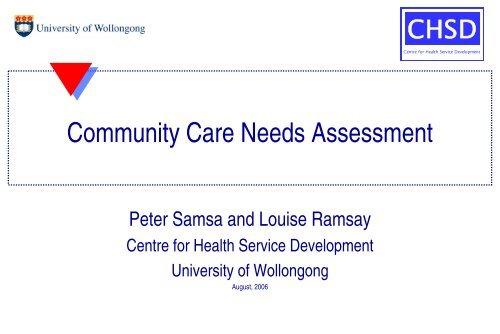

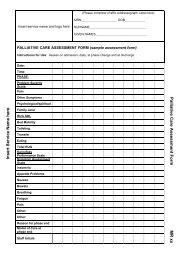
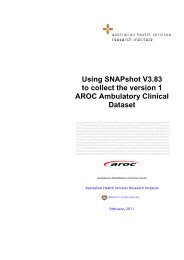
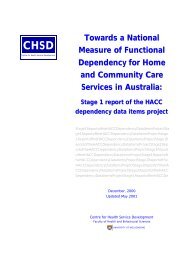
![[Insert Service Name Here] P C O C A S S E S S M E N T](https://img.yumpu.com/41607935/1/184x260/insert-service-name-here-p-c-o-c-a-s-s-e-s-s-m-e-n-t.jpg?quality=85)
